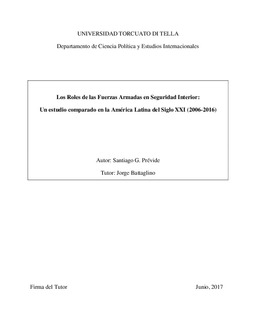| dc.rights.license | https://repositorio.utdt.edu/static/license/license-utdt.pdf | en_US |
| dc.contributor.advisor | Battaglino, Jorge | |
| dc.contributor.author | Prévide, Santiago G. | |
| dc.coverage.spatial | México | es_AR |
| dc.coverage.spatial | Argentina | es_AR |
| dc.coverage.temporal | 2006-2016 | en_US |
| dc.date.accessioned | 2017-10-09T01:56:34Z | |
| dc.date.available | 2017-10-09T01:56:34Z | |
| dc.date.issued | 2017-06 | |
| dc.identifier.uri | https://repositorio.utdt.edu/handle/20.500.13098/6527 | |
| dc.description.abstract | Este trabajo busca establecer los determinantes del tipo de rol que toman las fuerzas armadas latinoamericanas en seguridad interior a partir de los crecientes niveles de inseguridad y violencia de la región. A través de la comparación de las trayectorias de la militarización entre el caso mexicano, donde las FFAA se involucran de manera directa en el enfrentamiento contra el crimen y el caso argentino, donde las FFAA solo realizan misiones de apoyo logístico a otras fuerzas, se establecen cuáles son las principales características de estos tipos de involucramiento y se argumenta que el crimen organizado fuerte, la ausencia de fuerzas intermedias y la ausencia de un marco legal restrictivo favorecen el involucramiento directo de los militares en seguridad interior. Concluimos con una breve evaluación de las consecuencias del involucramiento directo de las fuerzas armadas en seguridad interior. | es_AR |
| dc.description.abstract | This article analyzes the determinants of the type of involvement of the Latin American armed forces in internal security missions in the context of rising levels of violence and criminality in the region. First we compare the trajectories of the militarization in México, where the armed forces are involved directly in the fight against organized crime, with Argentina, where the armed forces only participate providing logistic support to security forces, and establish the main differences between these types of involvements. Then, we argue that a strong organized crime, the absence of hybrid forces and the absence of a restricting legal framework favor the direct involvement of the armed forces in internal security missions. We conclude with a brief evaluation of the consequences of the direct involvement of the armed forces in internal security. | es_AR |
| dc.format.extent | 64 p. | en_US |
| dc.format.medium | application/pdf | en_US |
| dc.language | spa | en_US |
| dc.publisher | Universidad Torcuato Di Tella | en_US |
| dc.rights | info:eu-repo/semantics/openAccess | es_AR |
| dc.subject | Seguridad | en_US |
| dc.subject | Fuerzas armadas | en_US |
| dc.subject | Análisis comparativo | en_US |
| dc.subject | Crimen organizado | en_US |
| dc.subject | Tesis | |
| dc.title | Los roles de las fuerzas armadas en seguridad interior : un estudio comparado en la América Latina del Siglo XXI (2006-2016) | en_US |
| dc.type | info:eu-repo/semantics/bachelorThesis | es_AR |
| dcterms.description.tableOfContents | I. Introducción -- II. Misiones Militares y Seguridad Interior -- III. Determinantes del tipo de involucramiento de las FFAA en Seguridad Interior -- IV. Los Casos -- V. Explicación -- VI. Conclusiones -- Bibliografía | en_US |
| thesis.degree.name | Licenciatura en Ciencia Política y Gobierno | en_US |
| thesis.degree.level | 0 | en_US |
| thesis.degree.grantor | Universidad Torcuato Di Tella. Departamento de Ciencia Política y Estudios Internacionales | en_US |
| dc.type.version | info:eu-repo/semantics/acceptedVersion | es_AR |

